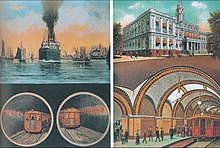 | |
| Overview | |
|---|---|
| Line | IRT Lexington Avenue Line (4 and 5 trains) |
| Location | East River between Manhattan and Brooklyn, New York |
| Coordinates | 40°41′49″N 74°00′26″W / 40.69694°N 74.00722°W |
| System | New York City Subway |
| Operation | |
| Opened | January 9, 1908[1] |
| Operator | Metropolitan Transportation Authority |
| Technical | |
| Length | 6,550 feet (2,000 m) |
| No. of tracks | 2 |
| Width | 16.67 feet (5.1 m) (exterior) 15.5 feet (4.7 m) (interior) |
Joralemon Street Tunnel | |
| Architect | William Barclay Parsons; Andrew McDonald, et al. |
| MPS | New York City Subway System MPS |
| NRHP reference No. | 06000015[2] |
| Added to NRHP | February 9, 2006 |
The Joralemon Street Tunnel (/dʒəˈrælɛmən/, ju-RAL-e-mun), originally the Brooklyn–Battery Tunnel, is a pair of tubes carrying the IRT Lexington Avenue Line (4 and 5 trains) of the New York City Subway under the East River between Bowling Green Park in Manhattan and Brooklyn Heights in Brooklyn, New York City. The Joralemon Street Tunnel was an extension of the Interborough Rapid Transit Company (IRT)'s first subway line from the Bowling Green station in Manhattan to the IRT Eastern Parkway Line in Brooklyn.
The tubes were constructed using the shield method and are each 6,550 feet (2,000 m) long and 15.5 feet (4.7 m) wide. The interiors are lined with cast-iron "rings" formed with concrete. The tubes descend 91 to 95 feet (28 to 29 m) below the mean high water level of the East River, with a maximum gradient of 3.1 percent. During the tunnel's construction, a house at 58 Joralemon Street in Brooklyn was converted into a ventilation building and emergency exit.
The Joralemon Street Tunnel was the first underwater subway tunnel connecting Manhattan and Brooklyn. It was built by the IRT as part of Contract 2, which the IRT signed with the Rapid Transit Commission in 1902. Construction commenced in 1903 and the tubes were completed by 1907, despite various construction accidents and engineering errors that required part of the tunnel to be rebuilt. The first train ran through the Joralemon Street Tunnel in November 1907, and the tunnel opened for passenger service on January 9, 1908. It was listed on the National Register of Historic Places in 2006.
- ^ Cite error: The named reference
Brooklyn Joyful Over Its Tunnelwas invoked but never defined (see the help page). - ^ "National Register Information System". National Register of Historic Places. National Park Service. January 23, 2007.